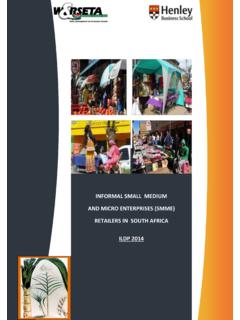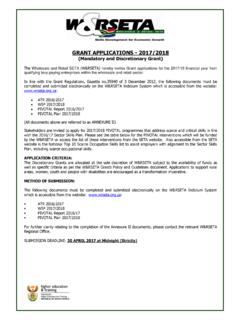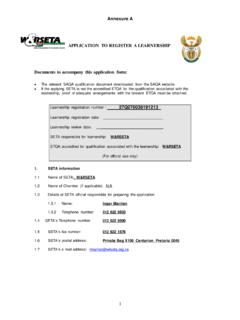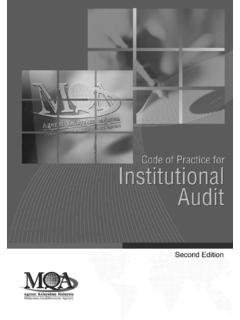Transcription of Criteria and Guidelines for Providers - W&RSETA
1 Criteria andGuidelines forProvidersP0 LICY DOCUMENTP lease refer any queries in writing to:The Executive OfficerSAQAA ttention: The DirectorQuality Assurance and DevelopmentRE: Criteria and Guidelines for ProvidersPostnet Suite 248 Private Bag X06 BROOKLYN0146 PretoriaSouth AfricaFax: (012) 346-5809e-mail: date: October 2001 ISBN: 0958441928 Funded by the European Union under the EuropeanProgramme for Reconstructionand DevelopmentCriteria and Guidelines for ProvidersTHE SOUTH AFRICANQUALIFICATIONS AUTHORITYT able of Contents1 Overview and Introduction5 The design of the Criteria and Guidelines for Providers6 Structure of the document6 Abbreviations and acronyms72 The NQF quality spiral8 Quality assurance and accreditation10 Linking standards setting and quality assurance together10 Aspects of the current system that need quality improvements123 Criteria and Guidelines for the Accreditation of Providers13 The scope for the accreditation of providers13A model for implementing ETQA accreditation13 Justifiable need16 Primary focus 16A model for Providers 17 Criteria for the accreditation of providers17 What are the
2 Frequently asked questions?17 Registration and accreditation18 Accountability for extension of accreditation18 Possible solutions18 Registration and accreditation 18 Accountability for extension of accreditation 18 What is a provider ? 19 Delivery only site19 Assessment only site19 Delivery and Assessment site20 What is the link between a provider and an ETQA?20 Criteria for providers21(a)Accreditation of registered providers22(b)Quality management system22(c)Learning programmes23(d)(i) Financial, administrative and physical resources24(ii) Staff selection, appraisal and development25(iii) Policies and practices for learner entry, guidance and support systems25(iiv) Policies and practices for managing off-site practical or work-site components 26(v) Policies and practices for the management ofassessment26 Appeals and procedures26(vi) Reporting procedures26 How do Providers identify an appropriate ETQA?
3 28 Terms and definitions30 Chapter 1 Overview and IntroductionCriteria and Guidelines for Providers5 The purpose of the Criteria and Guidelines for ProvidersIn 1999, the Authority approved the Criteria and Guidelines for ETQAs. This explanatorymanual follows directly on that approved document. It looks at the SAQA requirements forproviders within the structures and processes required for implementing quality assurancepolicies and mechanisms for the National Qualifications Framework. In keeping with the format adopted for the Criteria and Guidelines for ETQAs, this documentis situated within the enabling and regulatory framework provided by the South AfricanQualifications Authority Act, 1995 (Act of 1995), the Education and Training QualityAssurance Bodies Regulations, 1998 (Government Gazette , 8 September 1998) and theNational Standards Bodies Regulations, 1998 (Government Gazette , 28 March 1998).
4 It is this enabling framework, and the Criteria and Guidelines for ETQA sthat formed thebasis for the Criteria and Guidelines for Providers . In addition to this base, a range of nationalstakeholder policies and procedures for ensuring the quality of learning provision wereconsulted and, where appropriate, incorporated. Emerging trends and best practice fromlocal, regional and international experiences were also consulted in developing this , in keeping with the approach adopted for the Criteria and Guidelines for ETQAs,theparticular purpose of this document is to enable the implementation of quality assuranceand accreditation mechanisms for Providers . The contents of this document should not beviewed as only addressing themselves to a steady state of quality assurance and accreditationissues of big Providers , but as an enabling framework for Providers in a transitional state,including individuals and some forms of consultancies as well.
5 Aprocess approachhas been adopted which takes into account the needs for a phasing-inof some aspects of the system within the broader model of transforming the national educationand training system. Therefore, it is an approach that takes into account the current requirementsfor ensuring the quality of learning achievements and learning provision but which movestowards the implementation of the quality assurance processes required by the outcomes-basedand integrated model for education and training in the new system. A final point of departure for this approach has been the necessity to accommodate historically and statutorily separate stakeholders and processes in the educationand training system; build on the strengths and benefits of these different structures and systems to ensure thatthe short and long term requirements for implementing the National QualificationsFramework are met.
6 And make sure that these requirements ensure that there are continual and incremental qualityimprovements in the learning design of the Criteria and Guidelines for ProvidersThis document has been designed primarily as a guide for Providers to evaluate what theyneed to have in place to ensure the quality of learning provision and, what they need todemonstrate to the relevant Education and Training Quality Assurance body in order to beaccredited as a provider . This also implies that the Criteria and Guidelines for Providersshould not be viewed as minimum requirements for provision. Rather, they provide a guideas to quality processes and practices for all learning provision and learning are, thus, urged to use the Criteria and Guidelines for Providersas a living document to add their comments and notes, to insert copies of national, international, sectoral and/ororganisational quality statements, policies, procedures and practices, where appropriate this document is aimed at Providers , other accredited bodies within the system inparticular, Education and Training Quality Assurance bodies should consider the Criteriaand Guidelines for Providersas an example of what they would be expected to have in placein order to accredit Providers within their sphere of.
7 The style of the document should assist such bodies in evaluating their accreditationand quality assurance policies and proposals in respect of the overall SAQA Criteria of the documentThis first section deals with the purpose of the document. The second section deals with therelationship between accredited and accrediting bodies linked to the National QualificationsFramework and details the critical importance of quality learning provision to quality learningachievements. This section is intended to assist Providers in developing an understanding ofwhere they fit in within the scope of SAQA systems and operations, and the overall qualityrequirements for the accreditation third section the bulk of this document deals with the criteriafor the accreditationof Providers and provides guidelinesand examples of how these Criteria will be implementedand operationalised by SAQA through the.
8 QUALITYASSURANCE ANDDEVELOPMENT6 Criteria and Guidelines for ProvidersOverview and IntroductionCriteria and Guidelines for Providers71 Abbreviations and acronyms used in this documentPlease note that for the purposes of this document, Criteria principally refers to and includesthe statutory provisions of the SAQA Act as well as the ETQA list of the most common abbreviations and acronyms used in this document , Appendix A: Definition of Terms reproduces the definitions of SAQA terms usedin the Education and Training Quality Assurance Bodies Regulations, 1998 (September 1998)and the National Standards Bodies Regulations, 1998 (March 1998).ABETA dult Basic Education and TrainingCHEC ouncil on Higher EducationCTPC ommittee of Technikon PrincipalsECDE arly Childhood DevelopmentETQAE ducation and Training Quality Assurance BodyFETF urther Education and TrainingGENFETQA General and Further Education and Training Quality Assurance BodyGETG eneral Education and TrainingHEQCH igher Education Quality Committee (of the CHE)HETH igher Education and TrainingISOI nternational Standards OrganisationITBI ndustry Training BoardMQAM ining Qualifications AuthorityNQFN ational Qualifications Framework (also the Framework)NSAN ational Skills AuthorityNSBN ational Standards BodyNTBN ational Training BoardOBETO utcomes Based Education and TrainingQAQuality AssuranceQMSQ uality Management SystemQPUQ uality Promotions Unit (of SAUVCA)
9 RPLR ecognition of Prior LearningSAICAS outh African Institute for Charterd AccountantsSAQAS outh African Qualifications Authority (also the Authority)SAUVCAS outh African Universities Vice Chancellors AssociationSETAS ector Education and Training AuthoritySERTECC ertification Council for Technikon EducationSGBS tandards Generating BodyChapter 2 The NQF quality spiralDIRECTORATE:QUALITYASSURANCE ANDDEVELOPMENT8 Criteria and Guidelines for ProvidersUnderstanding quality assurance in respect of the National Qualifications Framework and whereproviders fit within the total quality systemThe structures and processes associated with the National Qualifications Framework can beconceptualised as a total quality system with built-in feedback mechanisms to ensureongoing improvements throughout the total quality system takes as its starting point the separation of standards setting andquality assurance functions as specified in section 5 of the SAQA Act, 1995 (Act of1995).
10 In particular, the Act specifies that SAQA shall implement the NQF through(a) the registration of bodies responsible for establishing education and training standards orqualifications; and(b) the accreditation of bodies responsible for monitoring and auditing achievements in terms of such standards and essence then, the quality process is a cycle within an upward spiral. This cycle can be seento begin with standards setting and the consequent registration of standards and qualificationson the National Qualifications Framework. Once registered, Education and Training QualityAssurance bodies (ETQAs) will be accredited to monitor and audit the achievement of aspecific set of such registered standards and qualifications. ETQAs, in turn, and amongst other functions, will accredit constituent Providers forlearning provision and assessment of learning achievements against these standards outline of NQF structures and systems below captures the dynamic relationshipbetween the separate functions of standards setting and quality evaluation and reporting requirements for accredited bodies provide a direct anddynamic feedback mechanism to standards setting and assist in ensuring the continualimprovement of NQF registered standards and qualifications.











